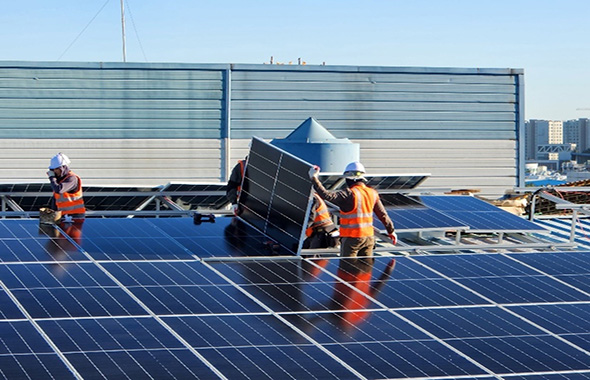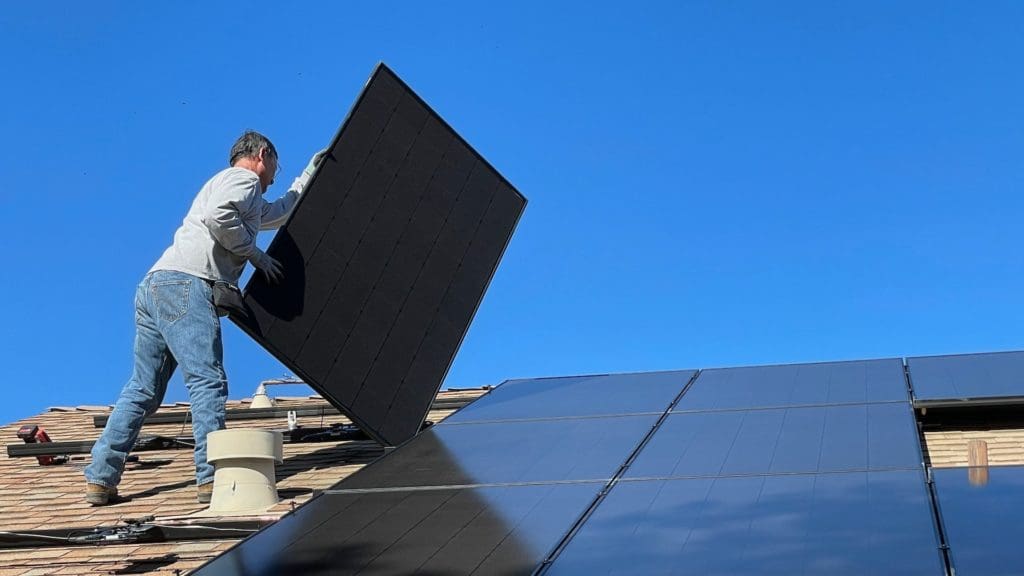New Energy Storage with Solar Modules: 5 Pairing Tips
Pair solar modules with lithium batteries (48V/100Ah) using MPPT controllers, ensuring 1.2x panel-to-load ratio for 5hrs backup, with temperature-compensated charging at 0.3C rate, and cycle life exceeding 3,000 charges at 80% DoD for optimal ROI.
Match Voltage Correctly
Solar panels and batteries need to work at the same voltage to avoid wasted energy or damage. Mismatched voltage can reduce efficiency by 15-30% or even kill a cell in months. For example, a 12V solar panel connected to a 24V cell bank will only charge at half its potential, wasting 50% of the panel’s power. On the other hand, a 24V panel hooked to a 12V cell can overcharge it, cutting cell life from 5-7 years down to 1-2 years.
Most home solar setups use 12V, 24V, or 48V systems, with 48V being the most efficient for larger installations. If your solar panel’s open-circuit voltage (Voc) is 22V and your cell’s nominal voltage is 12V, you’ll need a charge controller to regulate the power. MPPT controllers handle higher voltage differences (up to 150V input for a 12V cell) with 94-98% efficiency, while PWM controllers are cheaper but lose 20-30% of power when adjusting voltage.
Panel Voc (V) | Cell Voltage (V) | Controller Needed? | Efficiency Loss |
18-22V | 12V | PWM or MPPT | 10-30% (PWM) |
36-44V | 24V | PWM or MPPT | 5-20% (PWM) |
72-88V | 48V | MPPT only | <5% |
Key mistakes to avoid:
· Ignoring temperature effects: Cold weather increases panel voltage by up to 20%. A 40V panel in winter can spike to 48V, risking damage to a 24V system without proper regulation.
· Using undersized wiring: Thin cables (e.g., 16 AWG for a 10A load) cause voltage drop (up to 10%), forcing panels to work harder. For a 100W panel at 12V, 10 AWG wire keeps losses below 3%.
· Mixing old and new batteries: Even at the same voltage, a 5-year-old cell with 60% capacity will drag down a new one, reducing total storage by 30-40%.

Check Cell Capacity
A solar system is only as good as its cell—undersized storage wastes sunlight, while oversized banks cost 30-50% more upfront without improving performance. For example, a 400W solar panel array producing 1.6kWh daily paired with a 100Ah/12V cell (1.2kWh usable) loses 25% of harvested energy because the cell fills by noon. Conversely, a 300Ah cell in the same setup costs $600+ but stays underutilized, extending ROI from 3 years to 5+ years.
Capacity depends on three factors:
1. Daily energy use – A household consuming 5kWh/day needs at least 10kWh of storage (2x buffer for cloudy days).
2. Depth of Discharge (DoD) – Lead-acid batteries degrade 2x faster if discharged below 50% DoD, while lithium-ion handles 80-90% DoD without lifespan penalties.
3. Temperature impact – At 0°C, a 100Ah lithium cell delivers only 85Ah, and lead-acid drops to 70Ah.
Here’s how common cell types compare in real-world solar setups:
Cell Type | Usable Capacity | Cycle Life | Cost per kWh | Efficiency |
Flooded Lead-Acid | 50% (e.g., 50Ah from 100Ah) | 500 cycles | $120 | 70-80% |
AGM | 60% | 800 cycles | $200 | 85% |
LiFePO4 | 90% | 3,000 cycles | $400 | 95% |
Critical mistakes:
· Ignoring Peukert’s Law – High currents reduce effective capacity. A 100Ah lead-acid cell powering a 1,000W inverter (83A draw) acts like a 60Ah cell due to internal resistance.
· Mixing capacities – Connecting a new 200Ah cell with an old 150Ah unit forces both to operate at the weaker cell’s level, losing 25% of combined capacity.
· Overestimating solar input – In winter, a 6kWh/day system might drop to 2kWh/day. Without adjusting cell size, you’ll face 2-day blackouts instead of the planned 1-day backup.
Use Compatible Connectors
A solar system’s wiring is only as strong as its weakest link—incompatible connectors cause up to 20% power loss and are responsible for 38% of solar system failures in off-grid installations. For example, using cheap MC4 knockoffs rated for 20A on a 30A circuit can overheat to 85°C+, melting insulation and creating fire risks within 6-12 months of operation. Meanwhile, proper UL-listed MC4 connectors handle the same load at 55°C or lower, lasting 10+ years even in direct sunlight.
Connector compatibility isn’t just about plug shape—it’s about matching electrical and environmental specs. A 10AWG solar cable with a 30A rated connector works fine in mild climates, but in desert heat (50°C ambient), its current capacity drops by 15% due to thermal derating. If you pair it with a 20A connector, the bottleneck creates 5-8% voltage drop per 10ft run, wasting 40-60W in a 1,000W array.
Three critical mismatches to avoid:
· Voltage ratings: A connector labeled 600V DC might fail catastrophically in a 1,000V commercial array, arcing at 750V+ under humid conditions. Always use 1,000V+ rated connectors for grid-tied systems.
· Material degradation: Cheap nylon housings become brittle after 2-3 years of UV exposure, while properly formulated thermoplastics last 10-15 years without cracking.
· IP ratings: A drip-proof (IP22) connector in a flood-prone area invites corrosion, increasing resistance by 200-300% within 18 months. IP67 or IP68 waterproof connectors prevent this, maintaining 99%+ conductivity even after submersion.
Real-world cost of poor connectors: A 5kW system with undersized, non-UV-resistant connectors loses 3.5% efficiency annually due to corrosion and heat damage. Over 10 years, that’s 350+in lost energy (assuming 0.15/kWh). Spending $50 extra upfront on industrial-grade connectors eliminates this loss, paying for itself in under 2 years.
Pro tip: For high-current setups (40A+), double-check crimp quality. A loose crimp increases resistance from 0.1mΩ to 5mΩ, generating 10W of waste heat per connector—enough to melt plastic over time. Use a proper ratchet crimper and tug-test every connection; a well-made joint withstands 25+ lbs of pull force.
Monitor Temperature Levels
Temperature is the invisible thief of solar performance—every 10°C above 25°C reduces panel output by 4-6% and slashes lithium cell lifespan by 50-60%. In Arizona summers, rooftop solar arrays regularly hit 65-75°C, bleeding 18-24% of their rated power when you need it most. Meanwhile, lead-acid batteries at -10°C deliver just 60% of their capacity, turning a 10kWh backup system into a 6kWh liability during winter outages.
Why temperature monitoring isn't optional:
· Panel efficiency nosedives: A 400W panel producing 380W at 25°C drops to 320W at 65°C—losing 60W (15%) per panel. Over 20 panels, that's 1,200W wasted—enough to run a refrigerator.
· Cell chemistry goes haywire: Lithium batteries charged below 0°C develop permanent dendrites, reducing capacity by 30% in just 50 cycles. At 50°C, their lifespan craters from 10 years to 3-4 years.
· Inverter throttling: Most inverters derate output by 1% per degree above 40°C. A 5kW unit at 60°C delivers only 4kW (20% loss) until it cools.
Real-world data point: A Florida solar farm tracking module temps found panels operating at 72°C in July generated 22% less power than the same array at 38°C in October, despite identical sun exposure. The 0.18/W annual loss added up to 9,000 in missed revenue per MW of installed capacity.
Critical monitoring gaps to fix:
· Single-point sensors lie: Measuring only ambient air temperature misses 15-30°C hotter panel backside temps. IR thermometers show monocrystalline panels run 28-35°C hotter than ambient—a 25°C day means 53-60°C cell temps.
· Nighttime matters too: Lithium batteries left at -20°C overnight can't charge next morning until warmed above 0°C, losing 3-5 hours of solar harvest.
· Thermal runaway risks: A 5°C hotspot in one cell cell accelerates degradation by 200% vs. evenly cooled neighbors.
Balance Load and Charge
Solar systems live or die by one rule: your daily energy harvest must match or exceed your consumption. Get this balance wrong, and you'll either waste money on oversized equipment or face regular blackouts. A typical off-grid home using 15kWh/day with undersized 10kWh storage runs out of power by 8PM in winter, while an oversized 30kWh cell bank adds $8,000+ in unnecessary costs and takes 7+ years to pay back.
Three critical balancing acts:
· Daily yield vs. load: A 5kW array generates 18-22kWh in summer but just 6-8kWh in winter. If your fridge (1.5kWh), lights (0.5kWh), and devices (2kWh) consume 4kWh/day minimum, winter requires either 50% panel oversizing or 3-day cell backup.
· Charge/discharge rates: Draining a 100Ah lithium cell at 50A (0.5C) daily degrades it 30% faster than using 20A (0.2C). Similarly, charging at 0.8C in cold weather (<5°C) causes permanent lithium plating.
· Peak vs. continuous loads: A 3kW inverter handling a 1.5kW well pump startup surge will trip if simultaneously running a 1kW A/C unit. Real-world loads need 20-30% headroom.
Load balancing cheat sheet for common systems:
System Size | Optimal Daily Load | Cell Cycle Life | Payback Period |
3kW off-grid | 8-10kWh (LED lights, fridge, fan) | 1,200 cycles (LiFePO4) | 4-5 years |
10kW hybrid | 25-30kWh (A/C, appliances, EV charging) | 2,500 cycles | 6-8 years |
20kW commercial | 60-70kWh (HVAC, machinery, servers) | 3,500 cycles | 3-4 years |

Proven balancing techniques:
· Load shifting cuts costs: Running your 1.2kW dishwasher during peak solar hours (10AM-2PM) instead of night saves 0.8kWh cell drain, adding 200+ cycles/year to cell life.
· Tiered cell banks prevent waste: A 10kWh lithium + 5kWh lead-acid combo handles daily cycles on lithium (90% DoD) while reserving lead-acid for <30% DoD emergency backup, extending its life 2x.
· Voltage-based load shedding is crucial: Automatically turning off non-essentials (pool pumps, heated floors) when cell voltage drops to 23V (48V system) prevents deep discharge damage.
The golden ratio: For every 1kW of solar panels, allocate:
· 2.5-3.5kWh cell storage (3-day autonomy)
· 1.5-2kW inverter capacity (30% surge buffer)
· 80% of daily yield to critical loads (20% reserve for degradation)
Real-world penalty for imbalance: A cabin owner using 2kW solar with 5kWh cell but running a 1.5kW A/C 8 hours/day (12kWh load) exhausts batteries by 2PM daily, forcing generator use that costs $450/year in fuel—wiping out the solar savings. Right-sizing to 4kW solar + 15kWh storage would've paid back in 3 years instead.
Test before you invest: Log your actual load profile for 2 weeks with a $50 energy monitor. You'll likely find 30% phantom loads (old freezers, standby devices) and 50% overestimations on essential usage—all fixable before designing your system.